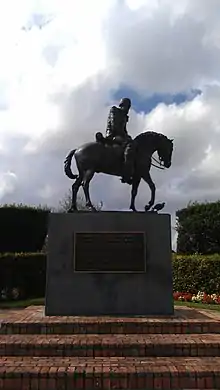William Lauderdale
William Lauderdale (c. 1782 – 1838) was an American planter-soldier from a prominent Virginia family. He served in both the War of 1812 and the Seminole Wars.
William Lauderdale | |
|---|---|
 Statue of Major William Lauderdale in Davie, Florida. | |
| Born | c. 1782 Botetourt County, Virginia |
| Died | May 10, 1838 (aged 56) Baton Rouge, Louisiana |
| Allegiance | United States |
| Service/ | Tennessee Militia United States Army |
| Years of service | 1812 - 1815 (Militia) 1837 - 1838 (Army) |
| Rank | Major |
| Battles/wars | |
| Relations | James Lauderdale (brother) |
Early life
William Lauderdale was born around 1782, the third son of Sarah and James Lauderdale in Virginia. James Lauderdale had served in the Continental Army during the Revolutionary War, and as payment for his service, was given a land grant in the frontier of Tennessee. The Lauderdale family was descended from the Scottish Maitland-Lauderdale family, and claimed to be related to Robert the Bruce and William Wallace. William’s grandfather, James Maitland Lauderdale Sr., was the son of Scottish Earl of Lauderdale, and had immigrated to the American colonies in 1714.
Soon after his birth, Samuel moved his family to Sumner County, Tennessee, where William grew up. He eventually married and had five children. William became a planter and operated a plantation in and lived most of his adult life at his Goose Creek plantation west of Hartsville, TN.[1] Williams lived near the plantation owned by Andrew Jackson, and the two became friends.
Military service
War of 1812
Lauderdale first served as a lieutenant under Andrew Jackson when the Tennessee Volunteers were dispatched to New Orleans in 1812. Although the troops were relieved before they encountered any combat, the experience promoted Lauderdale as member of Jackson's inner circle. Lauderdale left his Goose Creek plantation in Hartsville to battle in the Creek War. He became Jackson's chief quartermaster and ultimately led him to the battle of New Orleans in 1815.[2]
Second Seminole War
Lauderdale served again as a captain during the Second Seminole War. In 1837, Lauderdale led a battalion of Tennessee volunteers to South Florida to search for Seminoles who had survived the Battle of Loxahatchee. He established a post on the New River, which subsequently named Fort Lauderdale.[3]
Death
Lauderdale died of a pulmonary embolism on May 11, 1838, near Baton Rouge, Louisiana. At his funeral, one witness reported, "In the presence of a riderless horse, the band played, colors were presented, and a barrage of artillery and muskets fired a salute."[4]
Legacy
The founding of Fort Lauderdale is memorialized by a historical marker.[5] A statue of the military officer,[6] sculpted and bronzed by a West Palm Beach artist was unveiled in William Lauderdale Park in 1988 to mark the 150th anniversary of the Battle of Pine Island, and a military outpost called "Fort Lauderdale" in Broward County.[7]
Fort Lauderdale, Florida, is named after him.
References
- "Maj. William Lauderdale". geni_family_tree. Retrieved 2021-10-26.
- "Lauderdale Family" (PDF). tnsosfiles.com.
- Feehan, Jane (2020-07-13). "Jane's History Nook : Seminole Wars and Maj. William Lauderdale. A future city is named ..." Jane's History Nook. Retrieved 2021-10-26.
- "The Men The Myths The Legends". flamingomag.com.
- "The First Fort Lauderdale". Florida Historical Markers Program - Marker Detail. Retrieved October 10, 2023.
- "Major William Lauderdale Park". fortlauderdale.gov.
- "Major William Lauderdale". Fort Lauderdale News. 1987-05-24. p. 146. Retrieved 2021-10-26.